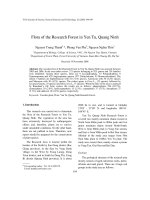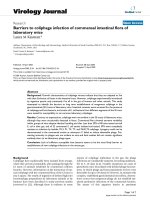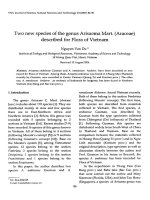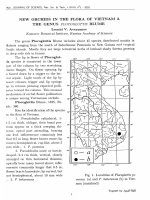Lichens flora of Phulchoki (Kathmandu)
Bạn đang xem bản rút gọn của tài liệu. Xem và tải ngay bản đầy đủ của tài liệu tại đây (139.68 KB, 6 trang )
LICHENS FLORA OF PHULCHOKI (KATHMANDU)
A. Devkota
ABSTRACT
Study of lichens flora of Phulchoki showed that this area is rich in
the lichen flora. A total of 250 different samples were collected from this
area. The identification of collected specimens was done on basis of their
morphological, anatomical and inimical studies. The lichens were collected
from different altitudinal gradients extending from 1500-2700m. above sea
level. The association of lichens with different substrata also studied. A total
of 32 species of lichens were identified, which encompass 9 families and 10
genera. Among them family Parmeliaceae was largest.
Key words: Lichens, Morphology, Jhayaoo, Anatomy, Thin layer
chromatography, Microcrystallography.
INTRODUCTION
In Nepali lichens are commonly known as Jhayaoo or Tare. They are
dual organisms, i.e. they ae product of mutually benefited two organisms
(Sharma, 1995). It is an association of a fungus (mycobiont) and an alga
(phycobiont). Abbout 13,500 to 17,000 species of lichens extend from the tropics
to the polar region. In Nepal, 471 spp. of lichens have been reported, of which 48
species are endemic. Baniya (1996) enumerated 99 species of lichens from Sikles
and Shivapuri. Lichens are pioneer groups of organism that initiate vegetation in
bare area. The components of lichen flora are governed by altitudinal variation.
The growth forms of lichen also vary. Usually in Terai and Siwalik belt with alt.
upto 1000m. the lichen flora consists of mainly crustose form. At higher alt. they
remain either in foliose or fructicose form.
Very little work has been done in Nepal till now. Most of lichens of
Nepal were recorded by foreigner as new record to science but not even a single
type specimen kept in our herbaria. Most parts of Nepal remain lichenologically
unexplored. It is felt that it is an important to make further exploration of lichen
in order to make complete study on plant kingdom. So present study was
undertaken with the objectives of collection of lichens and their identification.
MATERIALS AND METHODOLOGY
Materials were collected from Phulchoki (Ktm.) during 2nd Jan. 2003 to
9 Jan. 2003, by sampling 10m×10m quadrat and 5m×5m sub-quadrat (Vetas,
1997). Lichens growing on different substrata were collected by standwise
manner from 15000m to 2700m above sea level. All specimens were dried
properly and herbaria were prepared according to method given by Nash et al.
(1993).
th
IDENTIFICATION
LICHENS FLORA OF PHULCHOKI (KATHMANDU)
Lichens specimens collected during study period, were identified in the
laboratory of the Central Department of Boatny, Tribhuvan University, Kirtipur.
Each specimen was identified with the help of their morphology, anatomy, colour
reaction, thin layer chromatography, microcrystallography and cross-checking of
authentic samples deposited in Central Department of Botany.
To identify each genus and species, the Key to Macrolichens (Awasthi,
1988) and the Key to Microlichens (Awasthi, 1991) have been consulted.
RESULT AND DISCUSSION
A total of 32 species of lichens were identified in present study, which is
given below. Their family, from and chemical constituents were also given.
1.
Peltigera polydactyla (Neck.) Hoffm.,
Peltigereaceae
Thallus foliose, photobiont blue-green algae, muscicolous.
Chemical constituents - Tenuionin and Dolichorrhizin.
2.
Parmelia cirrhata Fr. Syst. Orb. Veget., 1:383, 1825;
Parmenaceae
Thallus corticolous, lignicolous, foliose, grey to dark grey.
Chemical constituents - Altranorin, Salacinic acid and protolochesterinic
acid.
3.
Parmelia nepalensis Tayl., London J. Bot. 6:172, 1847; Parmenaceae
Thallus corticolous, foliose, grey to dark grey
Chemical constituents - Atranorin, Salacinic acid, protolichesterinic
acid.
4.
Parmelia nilgherrensis Nyl, Flora, 52:299, 1869, Parmeliaceae
Thallus corticolous, foliose, grey.
Chemical constituents - Atranorin, Alectoronic acid, α-collatolic acid.
5.
Parmelia reticulata Tayl, In Mack, Fl. Hibern, 2:148, 1836,
Parmeliaceae
Thallus corticolous, Foliose, mineral grey to dark grey.
Chemical constituents- Atranorin, Salacinic acid.
6.
Parmilia sancti-angelii
Parmeliaceae
Lynge,
Ark.F.Bot.
13(13);
Thallus corticolous, foliose, grey to dark grey
Chemical constituents- Gyrophoric acid and Atranorin
35,1914;
TRIBHUVAN UNIVERSITY JOURNAL, VOL. XXVI, NO. 1, __________
7.
Parmelia tinctorum Nyl, Flora, 55:547, 1872; Parmeliaceae
Thallus conticolous, foliose, loosely to closely adnate to substracture
glaucose grey.
Chemical constituents- Atranorin, Lecanoric acid.
8.
Parmelia wallichiana Tayl. London J. Bot. 6:176, 1847; Parmeliaceae
Thallus corticolous, foliose, dark grey to whitish grey, rounded margin.
Chemical constituents- Atranorin and Salacinic acid.
9.
Parmelia sulcata Tayl. In Mack; Flora Hibernica, 2:145, 1836;
Parmeliaceae
Thallus corticolous, foliose, loosely attached to the substratum, rosette
from, bluish grey.
Chemical constituents- Atranorin, Salacinic acid, Protocetraric acid.
10.
Parmelia stuppea Tayl., Lond. J. Bot. Bot. 6:174, 1847; Parmeliaceae
Thallus corticolous, foliose, large, whitish grey, rotund.
Chemical constituents- Atranorin, Salacinic acid.
11.
Parmelia flesilis Kurok., In Hara, The flora of Eastern Himalaya, 607,
1966; Parmeliaceae
Thallus corticolous, foliose, closely adnate to the substratum, margin
creana whitisn grey.
Chemical constituents- Atranorin, protolichesterinic acid.
12.
Parmelaria thomsonii (Stirt) Awas. Journ. Hattori Bot. Lab. No. 63:368370,1987; Par4meliaceae
Thallus corticolous, foliose, loosely attached to thesubstratum, ashy grey
to grey.
Chemical constituents- Alectoronic acid and α-collatolic acid.
13.
Cladonia coniocraea (Flor.) Spreng. Syst. Veg. Linn., ed. 16, 4:277
1827; Cladoniaceae
Having primary squamules irregularly incised lobe, podetia cylindrical.
Chemical constituents- Fumarprotocetratic acid.
14.
Cladonic ramulosa (with.) Laundon, Lichenologist, 16(3):211-239,
1984 Cladoniaceae
Having persistent primary squamules, irregularly lobed, podetial cup
simple.
Chemical constituents- Fumarprotocetraric acid.
LICHENS FLORA OF PHULCHOKI (KATHMANDU)
15.
Heterodermia diademata Tayl., J. Bot. London, 6:165, 1847;
Physciaceae
Thallus loosely attached to the substratum. gravish white. lobes
dichotomously to irregularly branced.
Chemical constituents- Atranorin, Zeorin.
16.
Heterodermia dissecta (Kurok.) Awas. Geophy. 3(1):113-116,1973
Physciaceae
Thallus mineral greyish. closely appressed to the substratum. lobes
dichotomously to irregularly brached.
Chemical constituents- Atranorin, Zeorin, Salacinic acid, Norstictic
acid.
17.
Heterodermia incana (Stirt) Awas geophy. 3(1):113-116, 1973;
Physciaceae
Thallus whitish grey. attached centrallv to the subsstratum; foliose.
Chemical constituents- Atranorin, Zeorin.
18.
Heterodemia leucomela (L.) Massal, Mem. Lich 35, 1853; Physciaceae
Thallus mineral grey. Loosely attached to the substratum, lobes
dicholomously branched.
Chemical constituents- Atranorin, Zeorin, Salacinic acid.
19.
Heterodermia pseudospeciosa (Kurok) W.culb.Brovologist 69:484,
1966; Physciaceae
Thallus mineral grey to grey, loosely attached to the substratum,
growing in roucae parcnes.
Chemical constituents- Atranorin. Zeorin. Salacinic acid. Zeorin.
20.
Heterodermi punctifera (Kurok.) Awas, Geophy: 3(1):114, 1973;
Physciaceae
Thallus whitish grey, closely apprissd to the substratum, occurring in
small orbicurar partcnes.
Chemical constituents- Atranorin. Zeorin. Norstictic acid.
21.
Heterodermia speciosa Trev. Atti Soc. Ital. Sc. Nat. Milano xi:614,
1868: Physciaceae
Thallus whitish grey. closely appressed to the substratum.
Chemical constituents- Atranorin. Zeorin.
22.
Usnea aciculifera Vain Bot. Mag. Tokyo 35:45 1921; Usneaceae
TRIBHUVAN UNIVERSITY JOURNAL, VOL. XXVI, NO. 1, __________
Thallus corticolous, fructicose, decumbent to pendulous greenish yellow
to brown.
Chemical constituents- Usnic acid, stictic acid.
23.
Usnea orientalis Mot. Lich. Gen. Usnea stud. Monogr, Pars. syst.
547(1936-38); Usneaceae
Thallus corticolous, fructicose, erect upto 7cm, tall greenish grey.
Chemical constituents- Usnic acid. salacinic acid.
24.
Usnea thomsoni; stirt. Scoot Nature 6:107; 1881; Usneaceae
Thallus corticolous. Erect 5-7 cm tall, dark brown to black.
Chemical constituents- Usnic acid and Stictic acid compiex.
25.
Ramalina usnea (L.) Howe, Bryologist 17:81, 1914; Ramalinaceae
Thallus erect to subpendulous ribbon like thallus.
Chemical constituents- Sekikaic acid.
26.
Ramalina sinensis Jatta, Nuov. Giorn. Bot. Ital. 9:462, 1902;
Ramalinaceae
Thallus erect to subpendulous. Firmly attached to the substratum by
narrow basal disc, pale - grey to greenish grey.
Chemical constituents- Usnic acid.
27.
Stereocaulon coniophyllum
Stereocaulaceae
Lamb.
Journ
Hattori
Bot.
Lab.
Pseudopodetia sorediate, upto 5cm. Tall, robust, rigid.
Chemical constituents- Atranorin, lobaric acid.
28.
Chrysothrix chlorina (Ach.) Laundon, Lichenologist, 13(2):106-110
mm. diam.
Thallus thick, yellow cu/rust, croticolous. Granules 0.1-0.2 mm. diam.
Chemical constituents- calyan and Vulpinic acid.
29.
Leptogium delavayi Hue, Bull. Soc. Bot. France, 36:25, 1889;
Collemataceae
Thallus corticolous, as well as muscicolous onbark and stond, foliose,
dark grev to pate grey in dray.
30.
Leptogium resupinas, Nyl, Annal, Soc. Nat. Bot. 15(4), 368, 1861;
Collemataceae
Thallus foliose, upto 3 cm. in size, ashy grey when dry, olive green
when wet.
LICHENS FLORA OF PHULCHOKI (KATHMANDU)
Chemical constituents- No lichen substances.
31.
Leptogium indicum Awas, and P. Akhtar, Geophy: 8(2): 191-198, 1979;
Collemataceae
Thallus foliose, 3-6cm in size, light to dark lead grey when dry, olive
green when wet.
Chemical constituents- No lichen substances.
32.
Leptogium trichophiorwn
Collemataceae
Mull
Arg.
Flora
72;
505,
1889;
Thallus folise, upto 5cm in size, loosely attached to the substratum grey
brown to brown black when dry, dark olivaceus green when wet.
Chemical constituents- No lichen substance.
CONCLUSION
This paper has presented 9 families of lichens, they are under 10 genera
and 32 species, among them genus Parmelia is largest one.
WORKS CITED
Awasthi, D.D. (1988). A Kev to Macrolichens of India Nepal. Journ. Hattori Bot.
Lab. No. 65:207-302.
Awsthi, D.D. (1991). A Key to Microlichens in India, Nepal and Sri Lanka.
Bibliotheca Lichenlogia 40: 1-330.
Baniya, C.B. (1996). The Floristic Composition of Lichens in Sikles (Kaski) and
Shivapuri (Kathmandu) and their ecology. Thesis submitted for the partial
fulfillment of the requirement of the master degree in Botany.
Nash, T.H.: Wetmore, C.M.: Anderson. W.: Brat. C.: Denison. C.: Eversman. S.:
Murray, B.: Clari, L. (1993). Floristics, Lichens as Bioindicators of Air Quality
U.S. Deparment of Agriculture, Fort Collins, Colorado, General, Technical
Report. RM-224, 6-15.
Sharma, L.R. (1995) Enumeration of Lichens of Nepal, W.J.M. Verheught ed.:
Ministry of forest and soil conservation and Department of National Parks and
Wildlife conservation. Tech. Pub. No. 3. 1-111.
Vetaas, Ole R. (1997). Effect of Canopy disturbance on species richness in a
Centre Himalayan Or forest. Plant Ecology. 132-38.









